Shishigajo Castle
-Fusion of wild rock and modern structure-
Overview
Name: Shishigajo castle (Shishiga-jo)
Alias:
Place: Kyuragi-cho Karatu city, Saga
Location: 33.311993844854335, 130.04060391245335
Type: Mountain Castle
Built: 12th century
Remaining remnants: Stone walls, clay walls and dry moats
Title:
Shishigajo castle (獅子城) is located at Shiroyama mountain, one of about 150 meter high from its hillside in the south part of Karatsu city just next of Namise-toge pass.
Castle site is a little inside from Kyuragi area before, a town at the tip of narrow valley of Kyuragi-gawa river and also a middle point of mountainous road directly connecting Karatsu city and Saga area. Being located at the border area of Karatsu plain and Saga plain, Shishigajo castle had been an important border castle since medieval era.
Precise year is unknown but Shishigajo castle was built by Minamoto clan in 12th century. Minamoto clan was one of the branch families of Matsura party, a loose union of naval clans prospered since 11th century around northwestern coast of Kyushu island. But later Minamoto clan moved to Hirado area and Shishigajo castle was once abolished.
Matsura party flourished around Matsuura peninsula overcame severe damage suffered at the invasion of Chinese Yuan dynasty and Korean Koryo kingdom in 1274 and 1281. Marura party had many branch families around Higashi-Matsuura peninsura and Kita-Matsuura peninsula, and at Higashi-Matsuura peninsula Hata clan which was the lord of Kishidake castle at 10 kilometer north from Shishigajo castle became the leader of neighbor lords.
But since the beginning of 16th century, Ryuzoji clan which was the local lord of Saga plain gradually grew their power and overcame their lord Shoni clan. However, in 1545, Ryuzoji clan once fell by attack of other retainers of Shoni clan, and border to Saga plain became quite unstable.
Looking at this circumstance, Hata clan placed their relative Tsuruta clan at Kyuragi area as a vanguard to secure the border, then Tsuruta clan restored Shishigajo castle and entered in 1545. However, Takanobu Ryuzoji (1529-1584), the leader of Ryuzoji clan and brave general praised as “the bear of Hizen”, rapidly grew their power and seized whole part of Saga plain by 1570.
In 1570’s, Takanobu Ryuzoji attempted further expansion and advanced into northern and western part of Hizen province. Tsuruta clan fought against Ryuzoji army several times, and finally made peace and followed to them. Hata clan which was the leader of Matsura party at Higashi-Matsuura peninsula was weakened after severe internal conflict, then Hata clan also subordinated to Takanobu around 1580.
Ryuzoji clan which seized northwestern part of Kyushu island overwhelmed weakened Otomo clan and became one of the three strong powers of Kyushu island. But Takanobu was defeated by Shimazu clan which was the lord of Satsuma province (Kagoshima prefecture) at the battle of Okitanawate in 1584. Takanobu died in the battle, then Ryuzoji clan easily collapsed and lost their hegemony. After that Shimazu clan was on the corner to unite Kyushu island, but was subjugated by central ruler Hideyoshi Toyotomi (1537-1598) then lost most part of their occupied territory.
Under Toyotomi government Hata clan once survived as a feudal lord, but was later expelled because of non-obedience to Hideyoshi. After the fall of Hata clan, in 1593, Hirotaka Terasawa (1563-1633) who was the veteran general under Hideyoshi was appointed as a lord of Karatsu area. Hirotaka had a talent in management, and activated at the construction of Hizen Nagoya castle (Saga prefecture) at the coast of Karatsu area built as a headquarter of Hideyoshi for foreign expedition or supply mission. Hirotaka was virtually a representative of Hideyoshi at Kyushu region and care taker of Hizen Nagoya castle.
After the death of Hideyoshi, at the battle of Sekigahara between Ieyasu Tokugawa (1543-1616), the largest lord under Toyotomi government, and Mitsunari Ishida (1560-1600), a chief magistrate of government in 1600, Hirotaka supported Ieyasu who was the winner. After the battle, Hirotaka not only kept Karatsu area but also achieved Amakusa islands and became a large lord under Edo Shogunate. Hirotaka abolished Nagoya castle which was the symbol of former ruler, and newly built Karatsu castle (Saga prefecture) as his residence.
But Karatsu castle was at the center of his territory, and there was necessary to keep border castle near the road to surrounding provinces. For southward, there were two major roads from Karatsu city, the one spread to southeast to Saga city and another continues to southwest ward to Imari city. For the former road Terasawa clan reformed Shishigajo castle to modern castle and used it, and for the latter Kishidake castle, former main base of Hata clan was used.
Shiroyama mountain where Shishigajo locates is a long and narrow hill spreads east and west ward, and from its side it seems like a lying lion consist of nose at the tip, head at highest point, saddle point like neck behind head, flat back and tail. Shishigajo name means lion like castle, stem from this shape of the hill. The castle spread on the nose and head part of this mountain, about 100 meter tall from hillside at nose part and 150 meter tall at head part.
The core part of the castle spreads over the peak of about 300 meter long and 150 meter wide. Central area of the castle is a long and narrow terrace of 150 meter wide and 50 meter wide in western half of the hill, and surrounded by stone walls. At the most inside of the area there is a magnificent masugata style gate with folding path, but the road to this gate had disappeared and it is unknown how this gate is used. Stone wall of northern slope is directly built on almost vertical rock, and especially has a good structure at its northeastern corner.
In the eastern half of core part, ahead of Ido guruwa (water source well area), secondary area of 50 meter long and 20 meter wide exist. This secondary area is a huge bulk of rock itself, and no stairway except for a crack of rock is found then this area was connected to upper area only by bridge. This secondary area is wholly surrounded by third area at lower level, which is well bulldozed and being secured by stone walls and masugata style composite gates. At the east edge of third area there is also a secure main gate, but road to this gate is also unidentified.
At the southern slope just below the central area, long corridor like narrow area encircles from southward to westward of central area. As southern slope of the hill is relatively gentle and connecting to the valley might be used as intrusion route, then long stone wall exceeds 500 meter is built along with the southern slope like the Chinese wall.
Additionally, just below the central area, straight stone wall exceeds 100 meter long is constructed to separate the slope into upper terrace and lower one. This long and straight terrace might be used as a riding ground. Contrary to central area and secondary area keep atmosphere of medieval era, these lower level areas had modern elements such as linear stone wall and turret base, and might be added at the time of Terasawa clan.
Front side of core area is a sheer rock wall of over 30 meter height, as if it strongly denies the entrance into the castle. Ahead of saddle point over 50 meter wide currently used as a parking, outer area spreads along the ridge toward the eastern edge of the hill. These outer areas consist of three terraces which are separated by stone wall, and there might be watching tower at the tip of this area. Total length of this castle is nearly 500 meter, and is one of the largest castles of Hizen province in spite of its inland and mountainous location.
Shishigajyo castle was kept as a branch castle of Terasawa clan, but in 1616, based on “Ikkoku Ichijo Rei”(one domain one castle rule) published by Edo Shogunate, this castle was abolished along with Kishidake castle. Furthermore, strict politics of Terasawa clan at Amakusa islands became the cause of the rebellion of Shimabara in 1637, and Terasawa clan itself was extinct.
In spite of strict castle destruction after the rebellion of Shimabara to prevent reuse of abolished castle ruins, stone walls of the castle is considerably well kept. As next lords of Karatsu domain was hereditary retainer of Edo Shogunate, and castle site might be kept as a hidden base for accident. Combination of wild rock and line of half broken modern stone walls has a unique atmosphere not seen in other castles. This view is a proof of unchanged importance of this castle both in medieval and modern era.
30 minutes walk from JR Kyushu Karatsu line Kyuragi station. 10 minutes drive from Saga-Karatsu road Namise interchange to hilltop parking between core area and outer area.
Karatsu Castle -Picturesque castle at the coast-
Kishidake Castle -Magnificent mountain castle with sad history-
Type: Mountain Castle
Built: 12th century
Remaining remnants: Stone walls, clay walls and dry moats
Title:
Brief History
Shishigajo castle (獅子城) is located at Shiroyama mountain, one of about 150 meter high from its hillside in the south part of Karatsu city just next of Namise-toge pass.
Castle site is a little inside from Kyuragi area before, a town at the tip of narrow valley of Kyuragi-gawa river and also a middle point of mountainous road directly connecting Karatsu city and Saga area. Being located at the border area of Karatsu plain and Saga plain, Shishigajo castle had been an important border castle since medieval era.
Origin of Shishigajyo castle
Precise year is unknown but Shishigajo castle was built by Minamoto clan in 12th century. Minamoto clan was one of the branch families of Matsura party, a loose union of naval clans prospered since 11th century around northwestern coast of Kyushu island. But later Minamoto clan moved to Hirado area and Shishigajo castle was once abolished.
Matsura party flourished around Matsuura peninsula overcame severe damage suffered at the invasion of Chinese Yuan dynasty and Korean Koryo kingdom in 1274 and 1281. Marura party had many branch families around Higashi-Matsuura peninsura and Kita-Matsuura peninsula, and at Higashi-Matsuura peninsula Hata clan which was the lord of Kishidake castle at 10 kilometer north from Shishigajo castle became the leader of neighbor lords.
But since the beginning of 16th century, Ryuzoji clan which was the local lord of Saga plain gradually grew their power and overcame their lord Shoni clan. However, in 1545, Ryuzoji clan once fell by attack of other retainers of Shoni clan, and border to Saga plain became quite unstable.
Looking at this circumstance, Hata clan placed their relative Tsuruta clan at Kyuragi area as a vanguard to secure the border, then Tsuruta clan restored Shishigajo castle and entered in 1545. However, Takanobu Ryuzoji (1529-1584), the leader of Ryuzoji clan and brave general praised as “the bear of Hizen”, rapidly grew their power and seized whole part of Saga plain by 1570.
Ryuzoji clan and Matsura party
In 1570’s, Takanobu Ryuzoji attempted further expansion and advanced into northern and western part of Hizen province. Tsuruta clan fought against Ryuzoji army several times, and finally made peace and followed to them. Hata clan which was the leader of Matsura party at Higashi-Matsuura peninsula was weakened after severe internal conflict, then Hata clan also subordinated to Takanobu around 1580.
Ryuzoji clan which seized northwestern part of Kyushu island overwhelmed weakened Otomo clan and became one of the three strong powers of Kyushu island. But Takanobu was defeated by Shimazu clan which was the lord of Satsuma province (Kagoshima prefecture) at the battle of Okitanawate in 1584. Takanobu died in the battle, then Ryuzoji clan easily collapsed and lost their hegemony. After that Shimazu clan was on the corner to unite Kyushu island, but was subjugated by central ruler Hideyoshi Toyotomi (1537-1598) then lost most part of their occupied territory.
Total renovation by Terasawa clan
Under Toyotomi government Hata clan once survived as a feudal lord, but was later expelled because of non-obedience to Hideyoshi. After the fall of Hata clan, in 1593, Hirotaka Terasawa (1563-1633) who was the veteran general under Hideyoshi was appointed as a lord of Karatsu area. Hirotaka had a talent in management, and activated at the construction of Hizen Nagoya castle (Saga prefecture) at the coast of Karatsu area built as a headquarter of Hideyoshi for foreign expedition or supply mission. Hirotaka was virtually a representative of Hideyoshi at Kyushu region and care taker of Hizen Nagoya castle.
After the death of Hideyoshi, at the battle of Sekigahara between Ieyasu Tokugawa (1543-1616), the largest lord under Toyotomi government, and Mitsunari Ishida (1560-1600), a chief magistrate of government in 1600, Hirotaka supported Ieyasu who was the winner. After the battle, Hirotaka not only kept Karatsu area but also achieved Amakusa islands and became a large lord under Edo Shogunate. Hirotaka abolished Nagoya castle which was the symbol of former ruler, and newly built Karatsu castle (Saga prefecture) as his residence.
But Karatsu castle was at the center of his territory, and there was necessary to keep border castle near the road to surrounding provinces. For southward, there were two major roads from Karatsu city, the one spread to southeast to Saga city and another continues to southwest ward to Imari city. For the former road Terasawa clan reformed Shishigajo castle to modern castle and used it, and for the latter Kishidake castle, former main base of Hata clan was used.
Structure of Shishigajo castle
Shiroyama mountain where Shishigajo locates is a long and narrow hill spreads east and west ward, and from its side it seems like a lying lion consist of nose at the tip, head at highest point, saddle point like neck behind head, flat back and tail. Shishigajo name means lion like castle, stem from this shape of the hill. The castle spread on the nose and head part of this mountain, about 100 meter tall from hillside at nose part and 150 meter tall at head part.
The core part of the castle spreads over the peak of about 300 meter long and 150 meter wide. Central area of the castle is a long and narrow terrace of 150 meter wide and 50 meter wide in western half of the hill, and surrounded by stone walls. At the most inside of the area there is a magnificent masugata style gate with folding path, but the road to this gate had disappeared and it is unknown how this gate is used. Stone wall of northern slope is directly built on almost vertical rock, and especially has a good structure at its northeastern corner.
In the eastern half of core part, ahead of Ido guruwa (water source well area), secondary area of 50 meter long and 20 meter wide exist. This secondary area is a huge bulk of rock itself, and no stairway except for a crack of rock is found then this area was connected to upper area only by bridge. This secondary area is wholly surrounded by third area at lower level, which is well bulldozed and being secured by stone walls and masugata style composite gates. At the east edge of third area there is also a secure main gate, but road to this gate is also unidentified.
Fusion of wild rock and modern structure
At the southern slope just below the central area, long corridor like narrow area encircles from southward to westward of central area. As southern slope of the hill is relatively gentle and connecting to the valley might be used as intrusion route, then long stone wall exceeds 500 meter is built along with the southern slope like the Chinese wall.
Additionally, just below the central area, straight stone wall exceeds 100 meter long is constructed to separate the slope into upper terrace and lower one. This long and straight terrace might be used as a riding ground. Contrary to central area and secondary area keep atmosphere of medieval era, these lower level areas had modern elements such as linear stone wall and turret base, and might be added at the time of Terasawa clan.
Front side of core area is a sheer rock wall of over 30 meter height, as if it strongly denies the entrance into the castle. Ahead of saddle point over 50 meter wide currently used as a parking, outer area spreads along the ridge toward the eastern edge of the hill. These outer areas consist of three terraces which are separated by stone wall, and there might be watching tower at the tip of this area. Total length of this castle is nearly 500 meter, and is one of the largest castles of Hizen province in spite of its inland and mountainous location.
Afterward of castle
Shishigajyo castle was kept as a branch castle of Terasawa clan, but in 1616, based on “Ikkoku Ichijo Rei”(one domain one castle rule) published by Edo Shogunate, this castle was abolished along with Kishidake castle. Furthermore, strict politics of Terasawa clan at Amakusa islands became the cause of the rebellion of Shimabara in 1637, and Terasawa clan itself was extinct.
In spite of strict castle destruction after the rebellion of Shimabara to prevent reuse of abolished castle ruins, stone walls of the castle is considerably well kept. As next lords of Karatsu domain was hereditary retainer of Edo Shogunate, and castle site might be kept as a hidden base for accident. Combination of wild rock and line of half broken modern stone walls has a unique atmosphere not seen in other castles. This view is a proof of unchanged importance of this castle both in medieval and modern era.
Access
30 minutes walk from JR Kyushu Karatsu line Kyuragi station. 10 minutes drive from Saga-Karatsu road Namise interchange to hilltop parking between core area and outer area.
Related Castles
Karatsu Castle -Picturesque castle at the coast-
Kishidake Castle -Magnificent mountain castle with sad history-















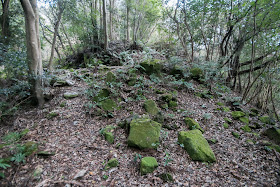




















































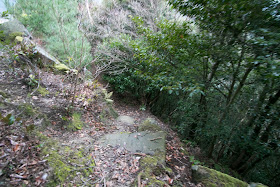







































































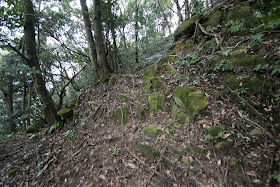





























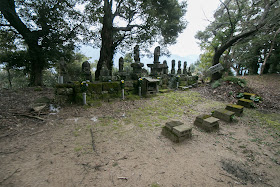








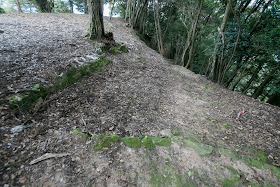












































































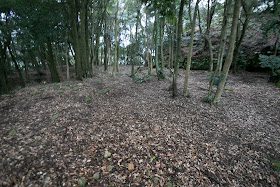












No comments:
Post a Comment